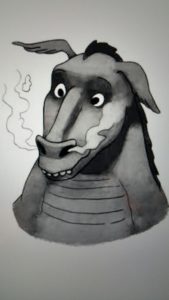The Dragon Grammar Book – Grammar for Kids, Dragons, and the Whole Kingdom
Finally! An easy-to-understand grammar book with a sense of humor. From multi-award winning children’s fantasy author, Diane Mae Robinson, The Dragon Grammar Book, featuring the characters of The Pen Pieyu Adventures series, introduces beginners to the basic rules of the English language. For middle grades to adults, The Dragon Grammar Book is an entertaining adventure into the mysterious Land of Grammar. Releasing late 2016

Endorsements
When Sir Princess Petra clobbers Snarls with a book, she uses the only book that can help her fire-breathing dragon-steed: The Dragon Grammar Book. This amazing book uses kid-friendly sentences, humorous illustrations, and easy-to understand examples. The Dragon Grammar Book is a fun tool that will help your middle-grade dragons better understand the basic rules of writing—and reading. —Sue Morris, Kid Lit Reviews
In her latest offering, Diane M. Robinson takes on a challenge greater than any of the obstacles which Sir Princess Petra has yet faced: how to make the arcane rules of English grammar interesting and accessible to a wider audience. While many kids and adults would rather face a fully-grown ogre than the laws of punctuation, The Dragon Grammar Book provides a clear and comprehensive look at our language for princesses and dragons alike. With clear examples and fun activities, this book is a must-have for readers and aspiring writers. —Peter Takach, High School English Teacher and Grammarian
The Dragon Grammar Book takes some of the basic rules of writing and makes them more approachable with a dash of creative fun courtesy of The Pen Pieyu all-stars. So whether you’re a sword wielding princess, an onion loving dragon, or an everyday Jane/Joe, you’ll walk away with a clearer understanding of the English language and be ready to tackle sentence structure and word usage with the best of them. —Gina Reba, Satisfaction for Insatiable Readers
Unbeatable winning combination . . . Sir Princess Petra faces her fears of the menacing fire-breathing dragon and conquers the pitfalls of grammar! Clever, painless, and fun way to learn, implement and test yourself in the English language. —Barbara Ann Mojica, Author of the Little Miss HISTORY children’s nonfiction book series, http://LittleMissHISTORY.com
Excerpt
Subject/Object of a sentence
Subject is the person, place, thing, or idea that is doing or being something. To find the subject of a sentence, ask “who” or “what” the verb is talking about. The dragon studies grammar.
“The dragon” is the subject, grammar is the object, and studies is the verb.
Sometimes, a subject can be more than one word and even be an entire clause. The rules about onion fighting could fill pages in the royal rule book.
To find the subject in the above sentence, ask “what” could fill pages in the royal rule book. The subject is therefore “The rules about onion fighting.”
The subject of a verb is not part of a prepositional phrase (phrases that start with words such as at, in, on, among, along, within). Prince Mesoggie, along with his puny army, have hung their wet clothes on the drawbridge.
In this sentence, both Prince Mesoggie and his puny army have hung out their clothes, but because “along with his puny army” is a prepositional phrase, the subject is “Prince Mesoggie.”
Usually, but not always, the subject comes before the verb in a sentence. Within the castle moat are several snapping crocodiles.
In this sentence, are is the linking verb following moat but moat is not the subject because “Within the castle moat” is a prepositional phrase. The subject crocodiles follows the verb.
Object is the person or thing that is affected by the action of the verb. There are three different kinds of objects.
Direct object is a noun, noun phrase, or pronoun that receives the action of the verb in a clause or sentence. The dragon studies grammar.
Grammar is the noun and direct object that follows the verb studies and completes the sentence of what the subject “the dragon” is doing.
Indirect object is a noun or pronoun that indicates to whom or for whom the action of a verb in a sentence is performed. When a verb is followed by two objects, the indirect object usually comes right after the verb and always before the direct object. The dragon gave her a book.
Her is the indirect object. The pronoun her comes after the verb gave and before the noun and direct object book and completes the sentence of what the subject “the dragon” did.
Object of a preposition is a noun, noun phrase, or pronoun that follows a preposition and completes the meaning of the sentence. The princess clobbered him with the book.
Book is the noun and the object of the preposition with and completes the sentence of what the subject “the princess” did. The dragon now reads in a cave.
Cave is the noun and the object of the preposition in and completes the sentence of what the subject “the dragon” does now.
*****The Dragon Grammar Book will be another release in the collection of dragon books for children by author Diane Mae Robinson.
copyright Diane Mae Robinson 2016
